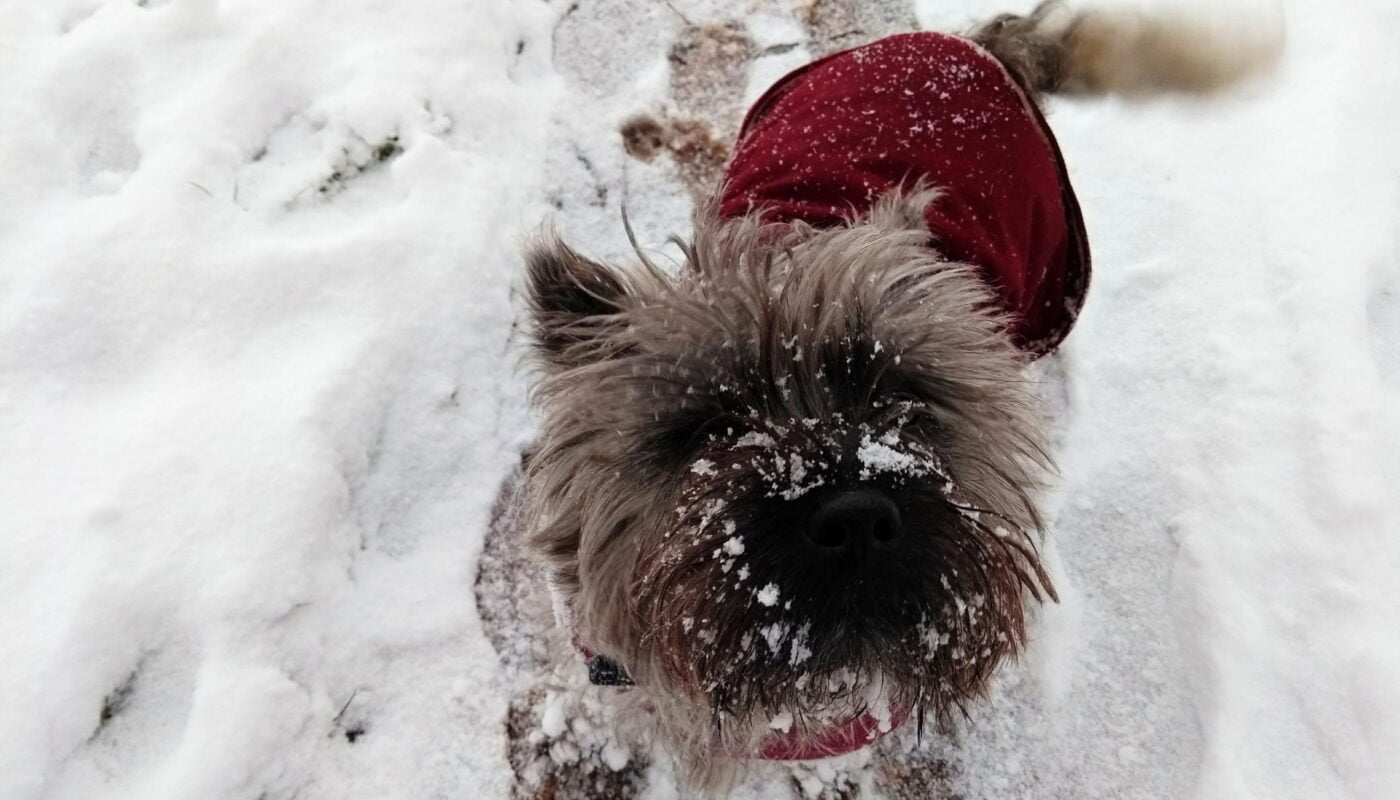Last Updated on 29/06/2025 by Claire Coney
Are you looking for a winter dog coat for your furry friend? You want to ensure your dog stays warm and cosy during chilly winter walks. But you are unsure which dog coat is right for them. I understand the confusion, especially since both of my dogs have different needs for winter dog coats.

In this post, I will provide a few pointers on choosing the perfect winter dog coat for your furry friend’s lifestyle. These practical tips will consider the size, shape, material, and style of the coat. Additionally, I will guide you on measuring your dog for a winter coat and explain how to ensure it fits your furry friend snugly.
By the time you finish reading this article, you’ll be well-equipped to pick a winter coat that will make your winter dog walks fun.
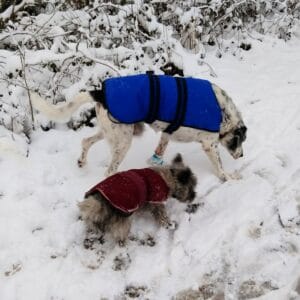
This post contains affiliate links. If you use these links to buy something, we may earn a commission. Thanks
Does Your Dog Need a Winter Coat?
There is no clear answer to this question. Some dogs need a winter coat, while others do not. Consider factors such as breed, size, age, health, and activity level. These factors determine how your dog experiences the cold and stays warm. They are important because they impact your dogs’ ability to regulate body temperature and handle cold weather.
Dog Breeds That Are Likely to Need a Winter Dog Coat
Some dog breeds have thin coats that offer limited protection against the cold. Some examples of these breeds are Greyhounds, Whippets, Chihuahuas, Smooth-haired Dachshunds, and Yorkshire Terriers. These dog breeds are likely to need a winter dog coat to ensure they are warm and cosy outdoors.
Dog Breeds That Are Not Likely to Need a Winter Dog Coat
Not every dog requires a coat, and a few may become too warm if they wear one. Certain breeds, such as Huskies, Malamutes, Newfoundlands, and Bernese Mountain Dogs, already have thick fur that naturally keeps them warm, so they do not need a winter dog coat to keep them warm outside.

Size and Body Fat
Different dogs vary in size and body type, resulting in variations in their ability to retain heat. Certain dogs are larger and have more body fat, which aids in heat retention. Larger or chubby dogs can withstand lower temperatures due to their increased body mass. Conversely, smaller or leaner dogs have less body fat, making it more challenging for them to stay warm. Therefore, small dogs are more likely to need a winter dog coat to stay warm and cosy when it is cold outside.
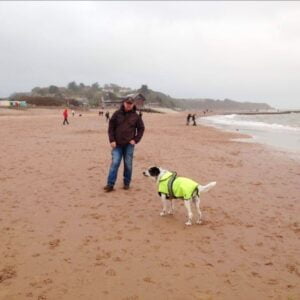
Age and Health
Young dogs usually have more energy and stamina, allowing them to stay active even in cold weather. On the other hand, older dogs, puppies, and dogs with health issues may also need extra protection from the cold. They may have weaker immune systems and a slower metabolism, leading to lower energy levels. As a result, they may need extra warmth to protect themselves from the dangers of hypothermia or frostbite. For example, my senior dog, Mr Nogood, had arthritis, which restricted his ability to run around. To help him stay dry and warm, I would keep him snug in his winter dog coat.
Activity Level
The need for your furry friend to have a winter coat depends on its activity level. If your dog spends time outside or enjoys playing in the snow, it might benefit from an extra layer of warmth. However, it’s important to mention that highly active dogs may not need a winter coat as they are more likely to overheat.
Take My Dogs for Example
Charlie is an English Springer Spaniel. He is lively and loves playing in water and mud. Spaniels are bred for outdoor work in any weather. They have a thick coat that keeps them warm but makes them prone to getting too hot.
That’s why I always dry Charlie before letting him in the car. I use micro towels to remove as much moisture and dirt as possible, and then I wrap him up snugly in a drying robe. This way, Charlie stays comfortable during the car ride and is completely dry when we get home. He only needs a winter coat in extremely wet and cold weather or when we go camping.

Abigail is a Cairn Terrier. She dislikes getting wet or feeling cold. Abigail enjoys sunbathing or cuddling up next to a heater, showing her love for warmth. Since Abigail is an older and less active dog than Charlie, she benefits from wearing winter coats designed for different situations and activities. It helps her stay warm and comfortable all winter.

Can My Dog Wear a Coat Indoors?
In most cases, dogs do not need coats when they are indoors. Take off the coat once you enter the house.
How to Measure Your Dog for a Winter Coat
To find the right size winter coat for your furry friend, you must measure their length, girth, and neck.
- The length is the distance from the base of the neck to the base of the tail.
- The girth is the circumference of the chest at the widest point.
- The circumference of the neck, where the collar sits.
You can use a tape measure or a string to take these measurements. Then, compare them with the size chart of the coat you want to buy. Make sure the coat fits snugly but not too tightly. It should cover your dog’s back and chest without restricting their movement or covering their genitals.
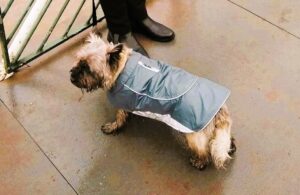
How to Check the Fitting of Winter Dog Coats
Once you have bought a winter coat for your dog, you need to check if it fits. Here are some tips to do that:
- Try the coat on your furry friend indoors before going outside. If your dog seems uncomfortable or tries to take it off, it might be too small, too big, or too itchy.
- Check that the coat does not rub or chafe your dog’s skin, especially under the armpits, around the neck, and belly.
- Check that the coat does not interfere with your dog’s collar, harness, or leash. You should be able to attach them securely.
- Check that the coat does not restrict your dog’s vision, breathing, or hearing. You should be able to see their eyes, nose, and ears.
- Check that the coat does not drag on the ground or get caught on objects. You should be able to lift it slightly with your fingers.

Types of Winter Dog Coats
There are many types of winter dog coats available, each with different features and benefits. Here are some common ones:
- Fleece coats: These are soft, warm, and lightweight coats that are easy to put on and take off. They are suitable for mild to moderately cold weather and for indoor use. You might like the Trixie Grenoble Dog Fleece Coat
- Quilted coats: These are padded and provide extra insulation and protection from wind and rain. They are suitable for moderate-to-severe cold weather and outdoor use. Try the Joules Quilted Dog Coat.
- Waterproof coats: These have water-resistant outer layers and a warm inner layer. They are suitable for wet and snowy conditions and for dogs that like to play in puddles or snow. The Henry Wag Waterproof Dog Coat is a good choice.
- Reflective coats: These have reflective strips or patches that make your dog more visible in low-light conditions. They are suitable for dogs that walk at dawn, dusk, or night. The Ancol Stormguard Hi-Vis Dog Coat are ideal for dark winter walks.
- Winter Dog Coats with Harness: These coats are made from durable weather-resistant materials that protect your dog from cold, wind, and rain, keeping them warm and dry during winter walks. Winter dog coats with harnesses combine warmth, safety, and convenience. This makes them an excellent choice for keeping your furry friend comfortable and secure during the colder months. The Trixie Pirou Dog Winter Coat with Harness Sangria are a wonderful example of this type of dog coat.

What are Some Brands of Winter Dog Coats?
You might be overwhelmed by the number of winter dog coat brands and options available. To help you narrow down your choices, here are some of the best dog coat brands of 2023, according to various sources and reviews:
Danish Designs
I love this brand because their winter dog coats are stylish and functional. The coats are made from high-quality materials and feature adjustable straps, reflective piping, and fleece lining. Abigail and Charlie look fabulous in the 2-in-1 Ultimate Dog Coat. It’s a practical coat that is easy to put on. It’s great for camping, too. The Danish Design is great for Mr Nogood as it goes under his chest as added protection.

Kurgo
This brand is ideal for dogs that travel. They are famous for their adventure-ready winter dog coats, designed to keep your dog warm and dry while exploring the outdoors. Their products are made from rugged and lightweight materials and have features such as zippered pockets, leash attachments, and LED lights. Some of their cool products are the Loft Dog Jacket, the North Country Dog Coat, and the Blaze Cross Dog Coat.
Collared Creatures Dog Drying Coat.
This dog coat is great for keeping your furry friend warm and dry. It’s made with a thick, absorbent cotton towel lining and a soft fleece exterior. Plus, it has a handy opening for quickly attaching a leash without taking the coat off. The Collared Creature Dog Drying Coat also features a waterproof zipper at the neck to let air in once your dog is dry, which can be opened up completely if needed. There are elastic straps for the back legs, along with strong velcro straps around the body. It’s a washing machine and dry it on a low setting.
Hurtta
This brand is known for its innovative and high-performance winter dog coats designed to protect your dog from harsh weather conditions. Their products are made from breathable and windproof materials and have adjustable collars, harness openings, and safety reflectors. Some of their top-rated products are the Razzel-Dazzel Dog Coat, the Expedition Parka Dog Coat, and the Rain Blocker Dog Coat.
Weatherbeeta
This brand is one of the leading manufacturers of horse blankets and has expanded its product line to include winter dog coats. Their products are made from waterproof fabrics and have features such as belly wrap closures, elastic leg straps, and reflective strips. Some of their well-known products are the Comfitec Classic Parka Dog Coat, the Comfitec Ultra Tough Dog Coat, and the Weatherbeeta Comfitec Premier Free Duo Deluxe Parka Dog Coat.
Digby and Fox
This brand specialises in colourful and fashionable winter dog coats designed to fit different breeds and sizes of dogs. Their products are made from durable and water-resistant fabrics and have fleece or faux fur linings for extra warmth. Some of their popular products are the Tweed Dog Coat, the Quilted Dog Coat, and the Waterproof Dog Coat.
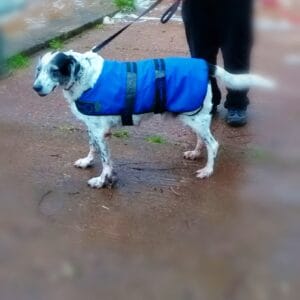
Ruffwear Overcoat Fuse Dog Jacket With Harness
This is a dog coat with a harness and will give your dog a seamless solution for getting outside in cold weather. Simply slip on, clip in, and go with this waterproof jacket that has a fleece lining for added cosiness.
The integrated harness means you can attach the lead at two leash points: one on the back and one at the chest. It’s also great for redirecting dogs that pull on-lead. You can put pop bags in the two zippered pockets, and you’ve got a Ruffwear Overcoat Fuse Dog Jacket Basalt that’s ready to go whenever you and your dog are.

How Do I Introduce My Dog to Wearing a Coat?
To help your dog feel comfortable with the winter coat, follow these steps:
- First, let your dog smell the coat and praise them.
- Next, put the coat on your dog gently and let them wear it for a few minutes. Give your dog treats to reward them.
- Then, increase the duration of wearing the coat until your dog is used to it.
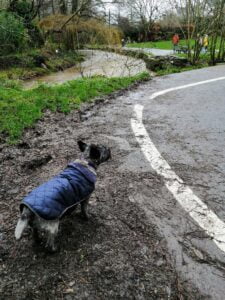
Weather Conditions
Consider the temperature and wind chill factor when choosing a winter coat for your furry friend. As a rule, if you feel cold, your dog probably feels cold. However, some dogs can tolerate lower temperatures than others, depending on their breed, size, age, and health. You can use a thermometer or an app to check the temperature and wind chill factor before going out with your dog.
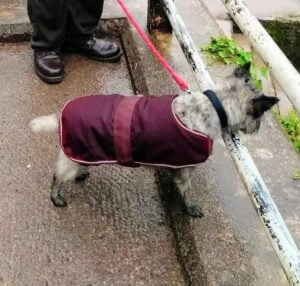
What Temperature Should I Put a Coat on My Dog for a Winter Walk?
There is no definitive answer to this question. Dogs have different needs and preferences when wearing a coat. However, some experts suggest that if the temperature is below 45°F (7°C), most dogs will benefit from wearing a coat, especially if they have thin or short hair, are small or elderly, or have health issues such as arthritis or diabetes. If the temperature is below 32°F (0°C), almost all dogs will need a coat unless they have extremely thick fur or are bred for cold climates, such as huskies or malamutes.
You are the one who knows your furry friend the best, so pay attention to their behaviour and body language to decide if they need a coat. If your dog is shivering, whining, lifting its paws, or seems uncomfortable, it might be too cold for them. In that case, put a coat on them or bring them indoors. A coat can keep your dog warm and cosy during the winter, but ensure it fits properly and does not restrict their movement or breathing. Additionally, check their coat for ice, snow, or dirt and dry them off after each walk. Remember, a coat alone is not enough to protect your dog from extreme cold. Limit their exposure to very low temperatures and provide them with warm shelter, food, and water.
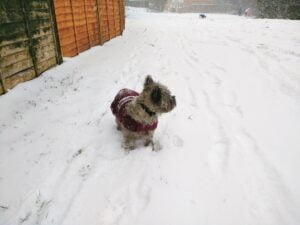
Wrapping It Up
Now that you have a clear idea of whether your dog needs a coat for winter walks.
Here’s a quick recap of the key takeaways:
- Choosing a dog coat for winter walks depends on several factors, such as your dog’s breed, size, shape, fur type, and activity level.
- Consider the weather conditions, the quality and durability of the coat, and your dog’s comfort, preferences and lifestyle.
- A dog coat should fit snugly, but not too tightly, and cover the most exposed areas of your dog’s body.
- A dog coat should also be easy to put on and take off, and be washable and waterproof.
By following these tips, you can find the best dog coat for your furry friend and enjoy the winter walks together.
Ok, now I want to know:
Did you decide to buy a winter coat for your dog?
Let me know in the comments below.
(Psss… read these 5 great tips on how to make winter dog walks fun.


